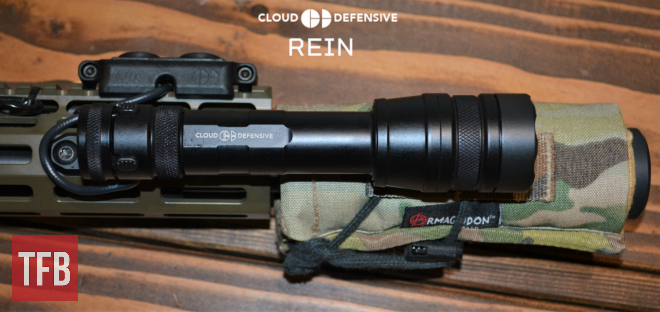It wasn’t long ago that if you wanted a light on your rifle, it was SureFire or nothing. With their company history stretching back nearly a half-century and key innovations in weapon-mounted flashlights beginning as early as the 1980s, it’s not hard to see why they were the kings of this particular hill for so long. In recent years, however, the market for tactical illumination has exploded. Usage and demand have soared, and as a result, many younger companies have arisen to challenge the SureFire giant. While this process has given us a veritable ocean of lesser products, it has also featured some phenomenal lights from other manufacturers. While SureFire still offers many excellent weaponlights, they no longer sit alone on the top shelf of this realm. For my money and from my experience, two companies, in particular, have emerged as the most capable direct SureFire long gun light competitors, in the majority of applications: the PLH and OKW models from Modlite, and the OWL and REIN lights from Cloud Defensive.
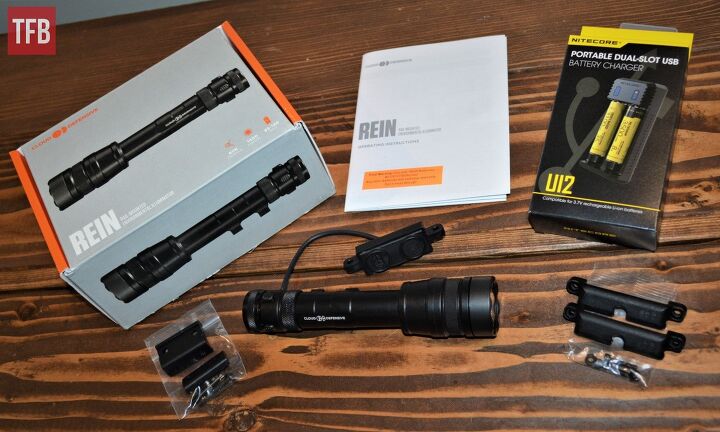
What’s in the box? Along with your light and one rechargeable battery, Cloud Defensive’s full kit includes everything needed to get it mounted on a pic rail and keep it running, as shown here.
Now, please allow me to clarify since I can already hear the collective “REEEEEEEE” emanating from the murky, fetid depths of the Gunternet. I’m not saying that SureFire, Modlite, and Cloud Defensive products are the only lights worth owning and using. I’m not casting aspersions on you if you have a Streamlight or anything like that. Some other makers’ options have their appropriate usage and may suit certain guns or situations. Though some other brands are junk, some can be viable options at a lower price point. The framework for this “top three” is in examining the rifle-focused weaponlights that generally perform the absolute best, stand up to the most punishing usage, and do not seek to sacrifice in any area for the sake of cost savings. Though these three are not the only options, I think it’s reasonable to say they are the true premium options. Fair? Good.
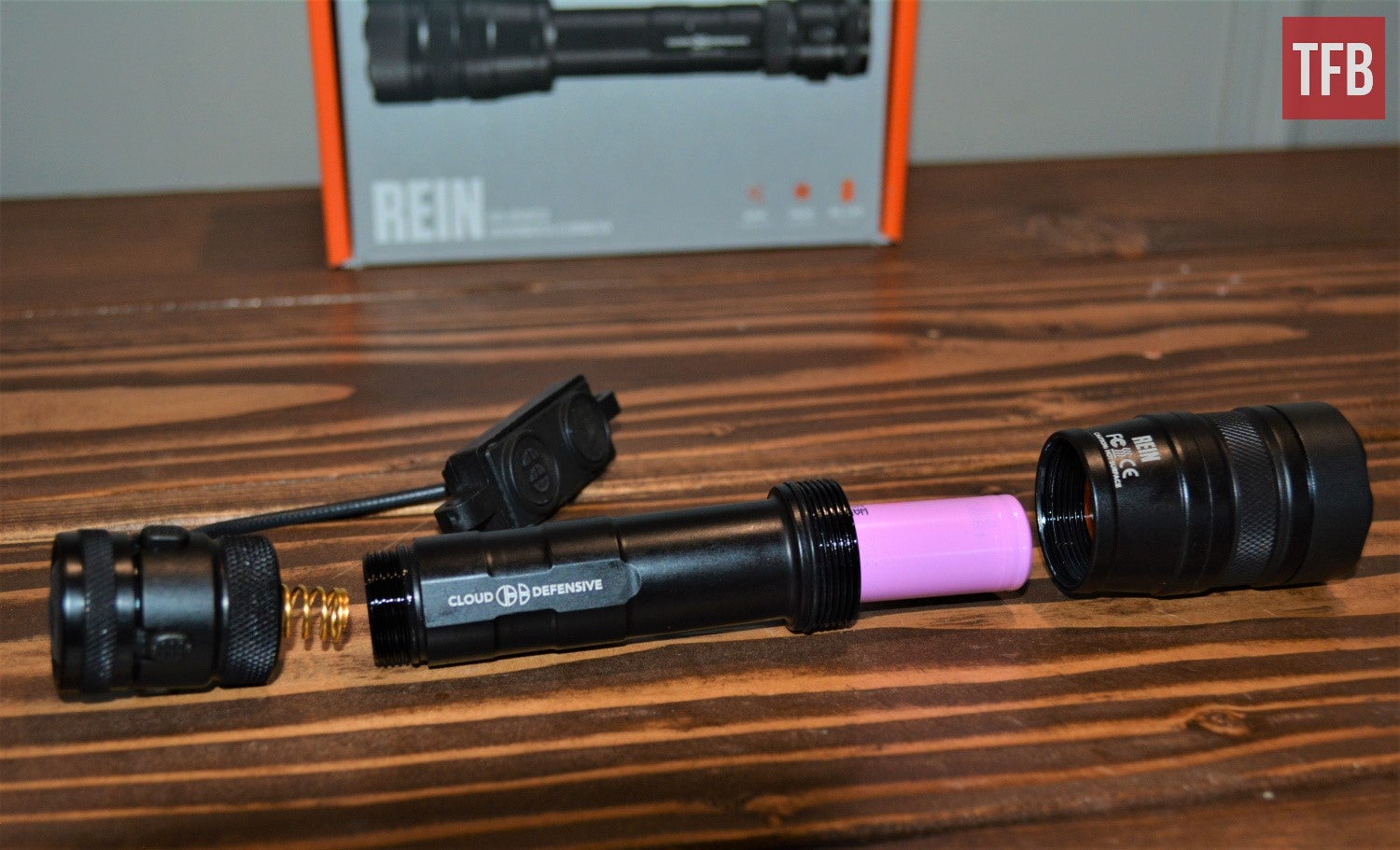
Breaking down the REIN’s major components, from the tail cap and switch to the body and battery to the head assembly.
The ideas behind both Modlite and Cloud Defensive are similar. They saw what was out there, and they set out to improve and innovate. Could lights be made better? Could they be made brighter? Enter the “Lumen Wars”. A lumen is defined by the General Conference on Weights and Measures organization as “…taking the fixed numerical value of the luminous efficacy of monochromatic radiation of frequency 540 × 1012 Hz, Kcd, to be 683 when expressed in the unit lm W–1…”. What does that mean in layman’s terms? The simple version, at least sufficient for our purposes here, is basically how much light can be produced. While far more than this actually goes into a light’s performance, such as candela, reflector loss, output over time, battery life, beam distance, and more, much has been made about how many lumens a weaponlight produces. While this number can be used in misleading marketing, the upshot is that the attention which has been paid to light performance in recent years has led to significant innovation and competition in the marketplace. This benefits consumers. We’ve come a long way from the days of the old 65 or 120 lumen Army-issued SureFire M951s.
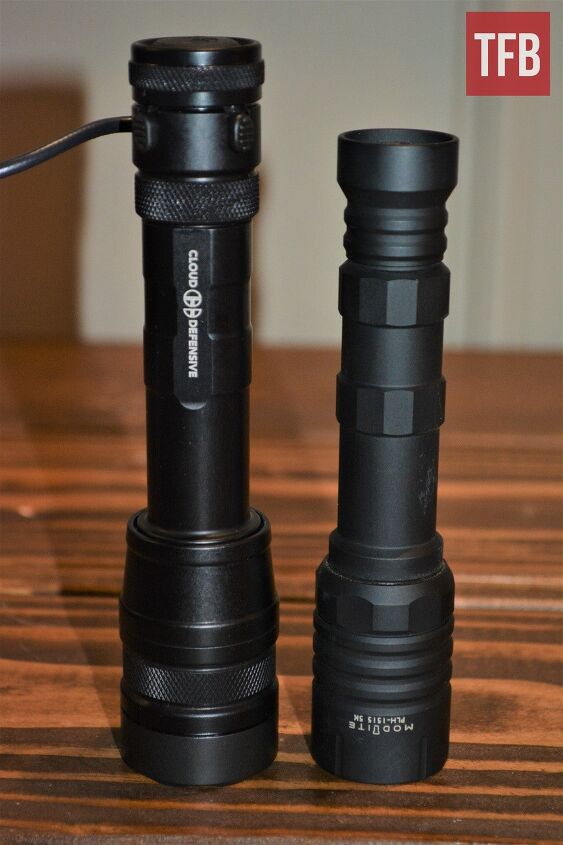
Size comparison between the REIN (just over 6″) and my Modlite PLHv1-18650 (approx. 1/2 shorter) from the side…
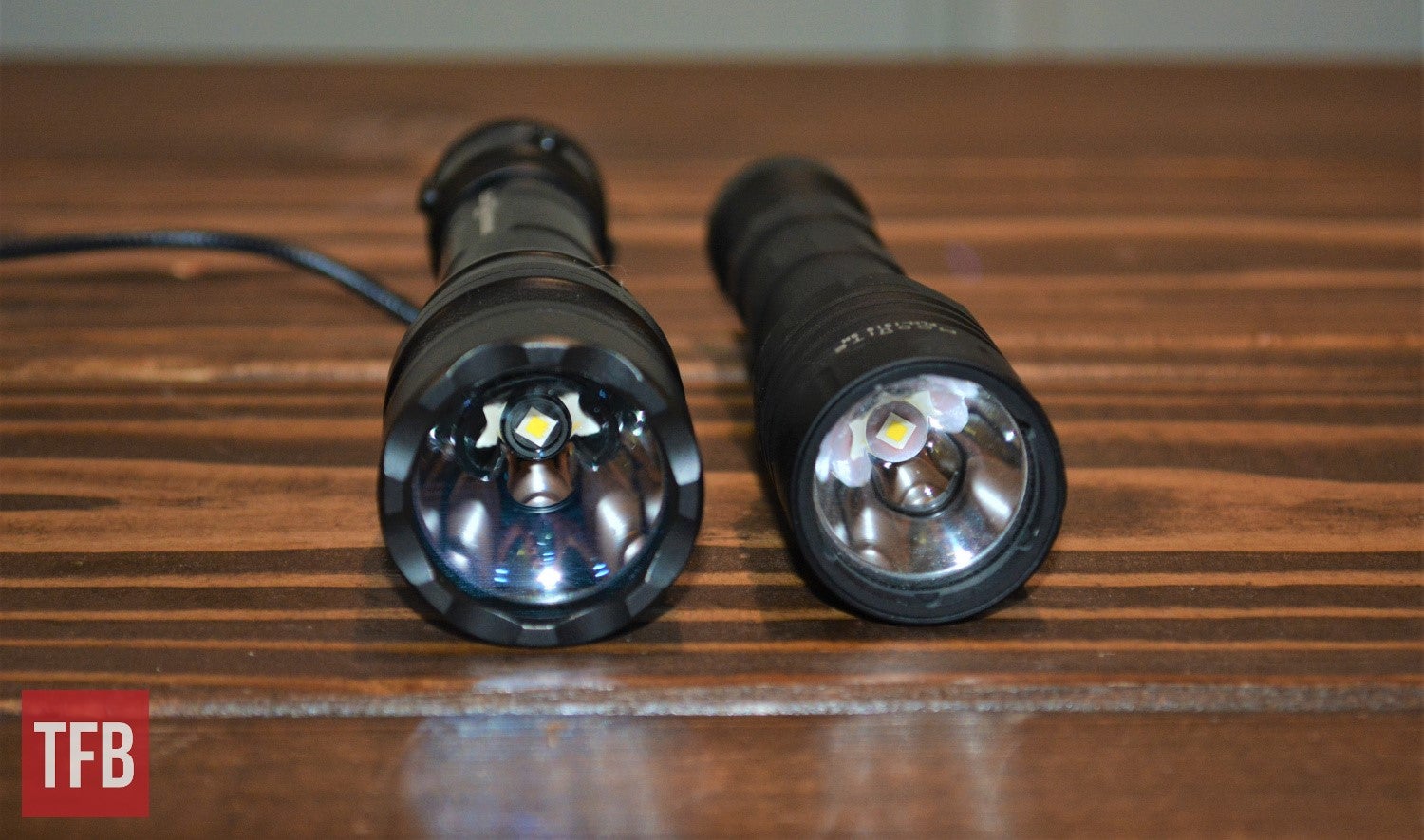
… and from the front. You can see that the REIN is slightly larger (weight is also about an ounce or so more), but not so much that it’s really noticeable in use.
How far have we come? Take Cloud Defensive’s first light offering, the OWL, or Optimized Weapon Light. First discussed in 2018, the OWL’s finalized version began widespread circulation in early 2019. The idea was to turn standard weaponlight design on its head, with the optimization or elimination of what they saw as potential problem areas like separate tape switches, external wiring, and threaded head/tail caps. With the OWL’s design, notably including the unibody integrated switch/Picatinny rail mount, its form resembles B. E. Meyers’ MAWL – and it is built like a tank. The OWL’s high performance in lighting capabilities was only matched by its durability, and for serious use, it quickly gained favor among shooters. The one main downside that some people saw, however, also went back to the OWL’s similarities to the MAWL. A good number of serious shooters run IR laser/illuminators, of which the MAWL is king, and the OWL’s design meant that it didn’t share rail space quite as well as some people would’ve preferred. And even for those who aren’t in the NODs game, some people prefer a bit more flexibility regarding light and switch positioning. If you were only running a white light on your forend and you wanted your switch at 12 o’clock, the OWL was tough to beat. Deviate from that setup, however, and you might’ve been encouraged to look elsewhere.
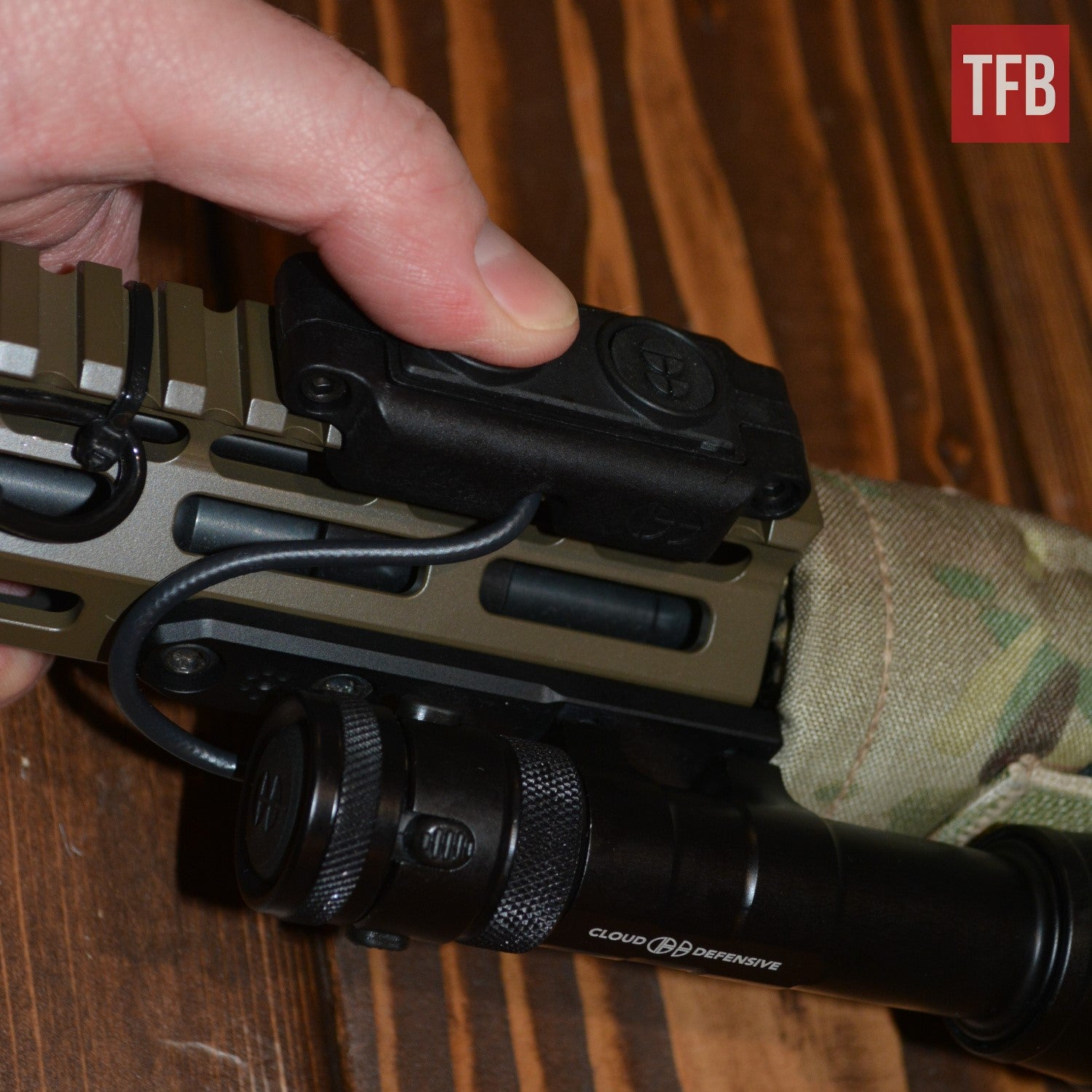
The remote switch is well thought out and works/feels great. The mount’s integrated cable management feature is a nice touch, as well.
That’s what I did. Since I primarily run a MAWL, when the OWL came out, I opted not to purchase one based on configuration. Yes, I know that it’s possible to run an OWL and a MAWL together if you position one or both of them off of the top rail, as our own Nick C. experimented with in his OWL review. However, though it is possible, it’s still sub-optimal if you have a common IR device – and I wasn’t going to ditch my MAWL. Thus, I determined it would be best for me to stick with a Scout Light. After years of mostly using SureFires, in late 2019 I bought a Modlite PLH, which I affixed to an Arisaka mount and added a Unity Tactical Hot Button. This has been a great setup with excellent light, but when Cloud Defensive announced their new REIN last year, I was intrigued. Their first weaponlight had been great in its niche; would the new one measure up with its more flexible setup application? Would it fall short, or exceed the performance of its competitors? Fortunately, following the REIN’s release in late 2020, Cloud Defensive got in touch with TFB to ask us to review the REIN, and I volunteered.
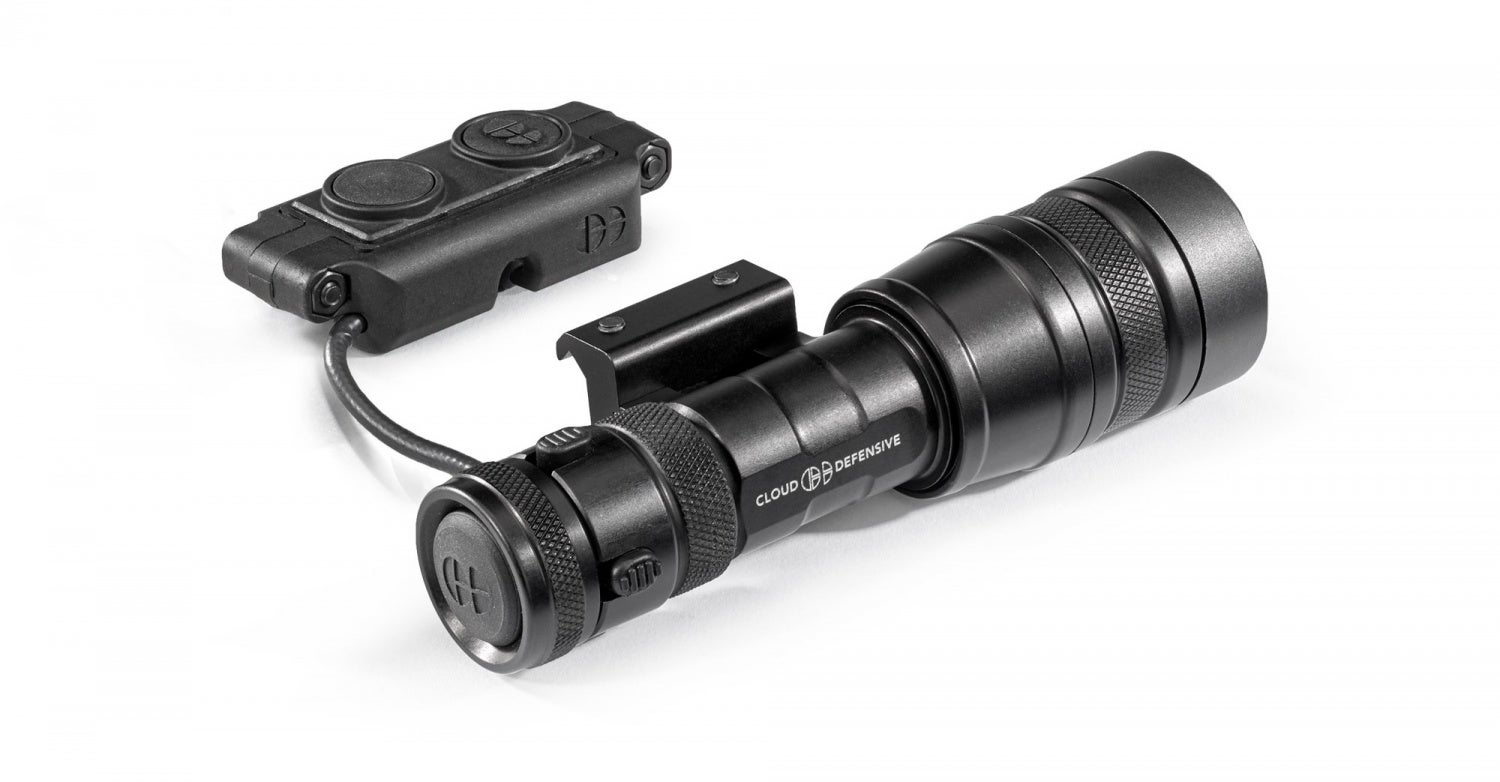
Cloud also offers a “Micro” version, employing an 18350 battery to shrink the light. It still manages to bring 1300 lumens and 55,000 candela, with the notable sacrifice being capacity. The 18350 model runs about 35 minutes per charge.
Upon receiving the demo unit, my first impressions of the REIN were good. Unboxing revealed what appeared to be a well-made, strong-feeling light body – substantial without seeming too heavy. It struck me as having that tank-like solidity which the OWL had become known for, but with less bulk. Compared to the monolithic OWL’s hefty 11-ounce weight including battery, the fully-loaded 18650 REIN tips the scales at a featherweight 6.9 ounces. Despite its relatively svelte frame, the REIN seemed like it would probably be durable enough to drive nails if need be (though that’s not recommended) (EDIT: I had intended the nail-driving statement as hyberbole, but then came across a video of Cloud actually doing this during their testing, amazing). They’ve used a lens tough enough to take multiple simunition hits at point-blank range, but still made it quickly, easily, and cheaply user serviceable (only $8 for a new 3mm replacement lens with o-ring on their website) if you somehow manage to break it. The body is machined from Certified 6061-T6 aluminum, with an S7 Tool Steel bezel ring that is heat-treated to 53 Rockwell. Clearly, the Cloud crew intended for this implement to take a licking and keep on ticking, and it shows. The demo light I was sent came as a full kit, with the remote switch included. You can also get the REIN with a mechanical push-button tail switch only if you prefer to eschew remote buttons.

Cloud Defensive’s website highlights the REIN’s particulars and solid attention to detail.
For me, the devil is in the REIN’s details. The folks at Cloud Defensive have clearly thought through every aspect of this tool, down to a painstakingly granular level. From the integrated mechanical push-button tail cap as a backup to the remote switch, to the field-serviceable lens, to the built-in cable management routing features, it’s obvious that great care has been taken to pay attention to complete optimization for real-world hard use. I found it exceedingly useful to be able to dial in the cable management setup through four positions on the tailcap and either the sides or front/rear of the LCS (Light Control System) switch mount. Even seeming minutiae like which exact moment that the constant-on switch activates, just after the click rather than before it, has a logical and tested reasoning behind it. Cloud themselves describe it best, in the REIN’s FAQs:
Historically, you press the constant-on button and with very little switch travel you turn the light on. With the REIN remote, you do do not engage constant-on mode until you full depress the switch and release it. This gives you instant and positive feedback on the status of the constant-on mode. There is no thinking you pressed the switch far enough. You either did or you did not. The real benefit of this design becomes apparently once the remote has engaged the constant-on mode. With a little pressure on the constant-on switch, you can now, for the first time on a weapon light, effectively kill your constant-on lighting, on a moments notice. This gives you a significant capability during employment of the light in the event you need to go dark instantly.
Another excellent feature is that the body is adjustable for different 18650 battery sizes. Different makes and models of 18650s can have some variation in their dimensions, usually depending on whether they have protected or unprotected coatings and button-top or flat-top construction. The REIN accounts for this by way of an interior battery jack that you can rotate more deeply or shallowly to account for a change in battery size. No matter how this is set, it provides you with solid electrical contacts for no loss of connectivity or power, including under heavy ballistic concussion. I never experienced any reliability issues or flickering or anything like that. This is a brilliant little touch that should allow your REIN to work with pretty much any 18650 out there. It genuinely appears that nothing on the REIN has been overlooked or compromised, which is not the most common or easiest achievement. I appreciate the readily-apparent effort that went into getting this light’s design and construction just about as close to perfection as possible. Cloud cares, and it shows.
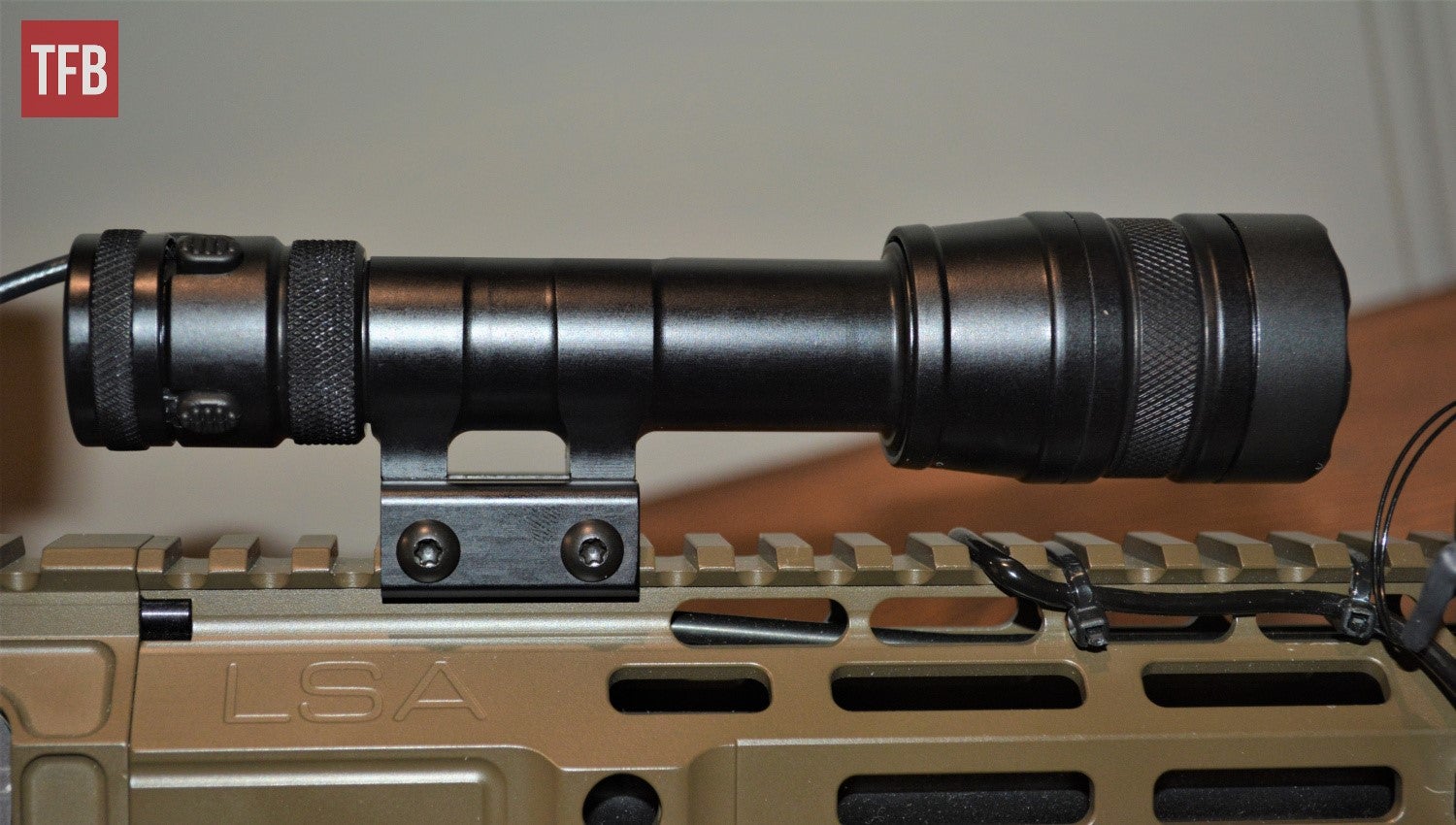
Pretty much the only thing I’d personally change is the included Picatinny mount. As you can see, the offset is a bit high. Thankfully, when I attached the light to an M-LOK Arisaka mount instead, it snugged the light up to my handguard perfectly.
Of course, the big question is performance. As a prior owner of Modlite and SureFire lights, and having tested numerous other brands, I was curious as to how the REIN would stack up. You can see a couple of examples in the photos below, but the bottom line is that this is a phenomenal illumination source with strong output. The light boasts 60,000 candela and 1400 lumens, which is substantial and edges out most competitors. As soon as I first clicked this light on, I was impressed, and continued testing only served to increase my affinity. The illumination worked exceedingly well both indoors and out, in a variety of lighting conditions, and at a range of different distances. One point I was interested in checking out was how the REIN would handle photonic barriers. Could its beam, for example, cut through a lit space into a darkened room beyond, or overcome an outdoor light like a streetlamp to see a darker area further out? Given the REIN’s advertised 1400 lumens and 60,000 candela power, it should come as no surprise that this was no problem for this powerhouse light (with apologies that my attempted photos didn’t turn out for this particular example). In every situation I tried, the REIN performed like a champ. It’s not only tough and ergonomic, but it’s also extremely bright and powerful. Once you factor in the advertised 2-hour runtime, which is at least as good as most competing products and better than the bulk of them, the REIN’s value proposition looks exceptionally strong.

An outdoor comparison shot, taken from about 50 feet away with suburban ambient nighttime lighting. To my eye, the REIN slightly edged out my v1 Modlite PLH on brightness and throw as you started to get further out, past CQB distances.
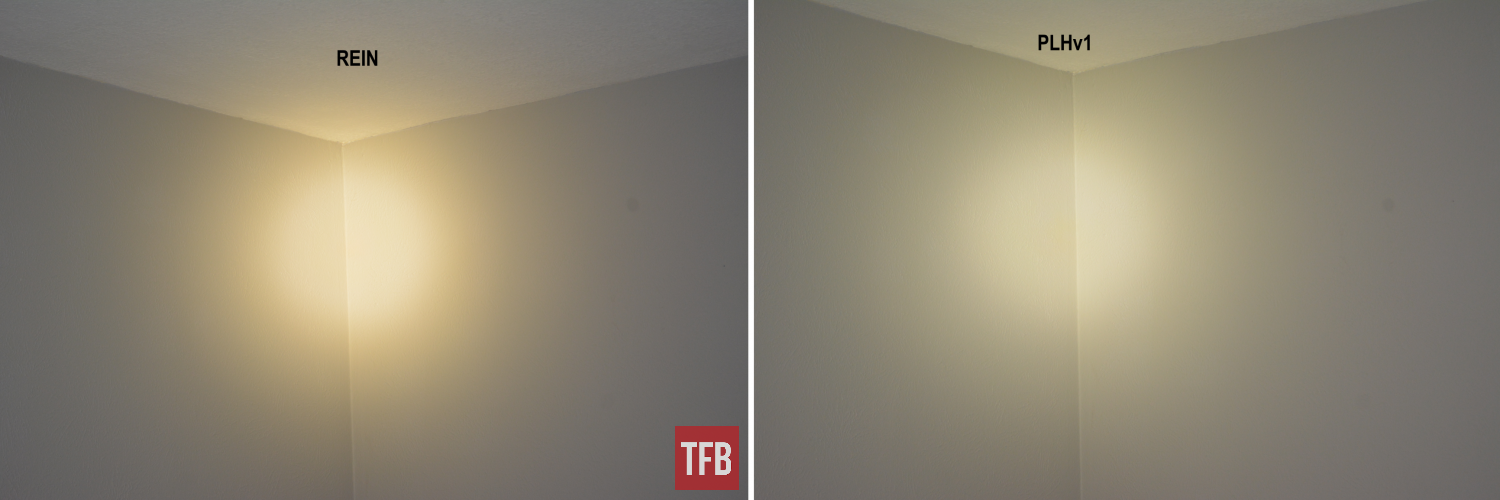
This close-range indoor comparison better highlights the difference between the REIN’s warmer light color temperature, versus my Modlite’s cooler, more bluish/whitish hue. These were taken in a fully blacked-out room with no other lighting.
Bottom line on the REIN:
Cloud Defensive nailed it with this light. Taking nothing away from other top-tier weaponlights, the early verdict on the REIN is that it solidly appears to be one of the best long-gun illum options on the market today. To me, the choice between the top three brands comes down to personal preference and picking nits. SureFire, Modlite, and Cloud Defensive are all offering outstanding products that I believe absolutely justify their prices. After my hands-on experience with it, I can confidently assert that the REIN has thoroughly earned its place on that top shelf. You might prefer SureFire’s brand longevity, or Modlite’s slightly smaller footprint and PLH/OKW head specialization, and I wouldn’t fault you. However, if you are not strongly considering a REIN for your next premium weaponlight purchase, you would absolutely be missing out.
This is a phenomenal illumination tool, with which I have great difficulty finding any real fault. I would be completely confident recommending it to anyone who wants the best, including my friends in the military or law enforcement for whom duty gear can be a literal matter of life or death. I trust that if and when you may need it most, the REIN would not let you down. Perhaps the strongest endorsement I can give is this: after my experience testing a demo model firsthand, I now have my own personal REIN affixed to the bedside AR that I would call upon in an emergency, to defend my family’s lives in the night if the worst ever occurred. Is it the most wallet-friendly product? No; you could save a few bucks elsewhere. But does it warrant its $359.99 MSRP (for the 18650 complete kit as tested), is it worth spending a little more to buy a REIN? Every bit and then some. Also consider that for the price, you’re getting a complete setup including remote switch, a clicky tailcap, and a mount. Push comes to shove, even with some other quality options on the market, this has become my new favorite long gun light. I’ve been thoroughly pleased with it, and I think you will be, too. See you at the range!
Photos courtesy of the author and Cloud Defensive.
We are committed to finding, researching, and recommending the best products. We earn commissions from purchases you make using the retail links in our product reviews. Learn more about how this works.
 Your Privacy Choices
Your Privacy Choices
